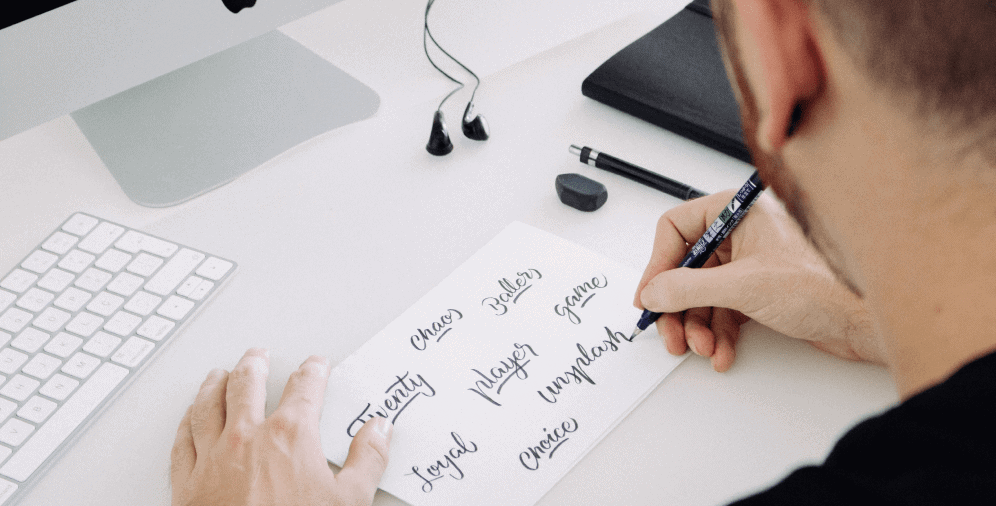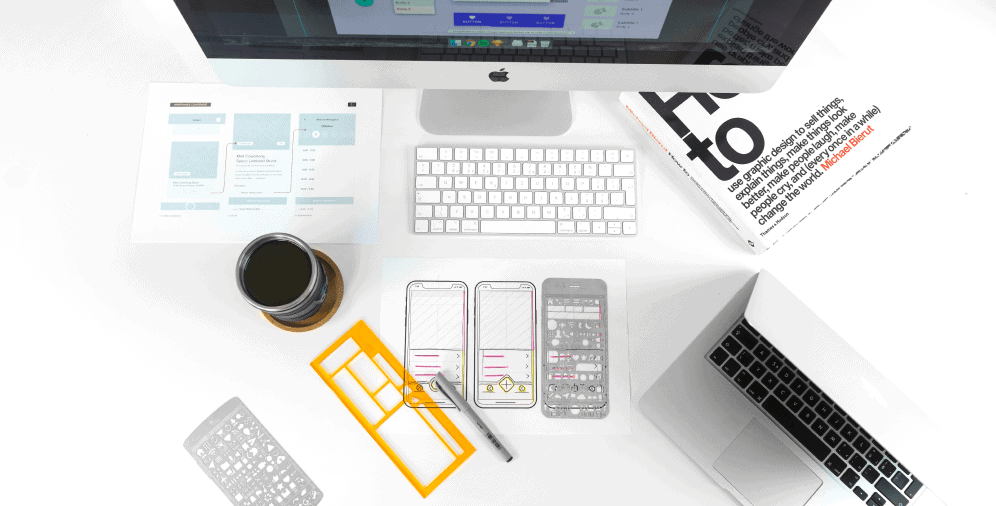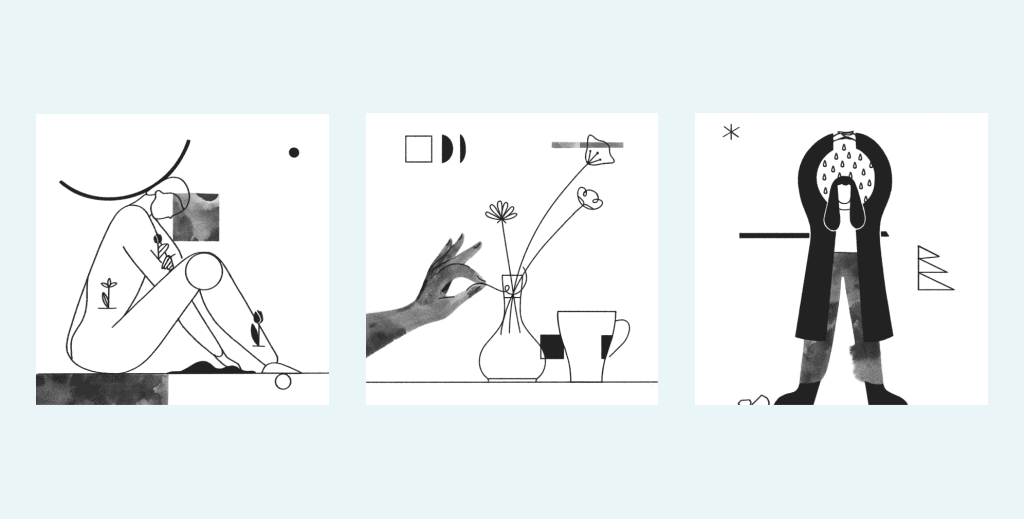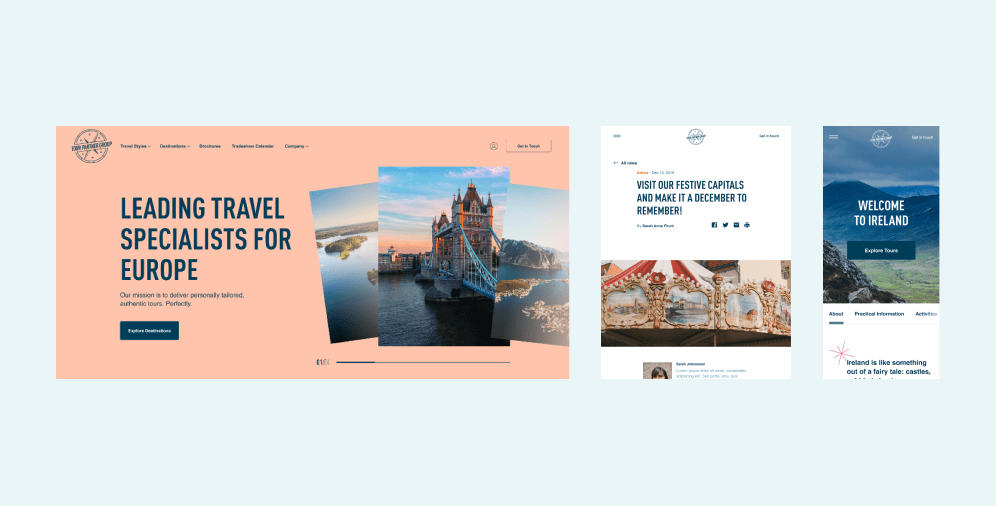Outline:
Many of us might believe that spending our daily subway commute browsing Pinterest accounts and liking artistic posts on Instagram is enough to cultivate an impeccable taste in design. However, the truth is that this perception is far from reality. It is important to acknowledge that graphic design involves intricate processes that cannot be mastered instantly.
Thus, simply looking at aesthetically pleasing images is not enough to be considered an expert in the field. If we were to be placed in a room full of designers, it is highly unlikely that we would be able to perform at the same level as them. So, we compelled a graphic design guide to help you understand its concept and to get you covered on its main principles.
The Power of Visual Communication: A Graphic Design Guide
The human mind is a complex thing, and it can be challenging for us to focus on any text for extended periods of time or to process information quickly and accurately if the text is too dense. We tend to perceive images much faster than words, and in a world where we are bombarded with copious amounts of data and information every day in various visual media, we become picky and desensitized to the variety of content. As a result, we strive to gravitate towards more nuanced and sophisticated forms of presenting that content, and that is where graphic design comes in.
Nowadays, most of the content is created and distributed through digital media, and the easiest way to grab people’s attention online is through an engaging arrangement of photos, a colorful logo, or anything visually compelling. Graphic design has rightly become one of the most popular and rapidly developing design spheres for responding to that insatiable need for visual content. However, what exactly is graphic design, and what is its purpose?
Graphic design is a creative process that involves the use of typography, photography, iconography, and illustration to communicate certain ideas and concepts through visual compositions. It blends text, image, and symbols to provide a visual representation of a message and to showcase the function of the presented information. It is often referred to as communication design because its main purpose is to project a specific point to an audience creatively and engagingly.
Many people believe that, in today’s world, graphic design is not just a marketing tool; it is an art form and a modern means of artistic expression. As we become more and more entrenched in the digital world, it begins to play a bigger role in our lives, encompassing most of the spheres we engage in. Its power lies in its inclusivity and range of use, and it can be utilized in advertising, on websites, in branding, printing, packaging, and much more. In conclusion, graphic design is not merely about making things look good; it is about communicating ideas effectively and creatively through visual means.

From Print to Digital: A Look at Various Types of Graphic Design
Graphic design is a multifaceted field that encompasses a wide range of design disciplines, each with its own unique function and purpose. Let’s discuss the six main areas of graphic design and their functions:
Brand Identity Graphic Design
Brand identity design focuses on creating a visual consistency for a company or organization by developing logos, typography, brand books, and visual style guides, utilizing a selected color scheme across all applications and media, and establishing a brand’s visual voice.
Marketing Graphic Design
Marketing graphic design is a powerful tool for advertising and making a certain product or idea stand out. This type of graphic design takes into account the product’s specific and unique qualities and makes the most of them. It can take the form of marketing presentations with creative infographics, social media ads and graphics, or other captivating visual elements.
Print Graphic Design
Publications and print graphic design are concerned with creating pieces that are distributed via print media. With the rise of digital publication companies, publication design now addresses the needs of various digital publishing platforms.
Packaging Graphic Design
Packaging design makes it easier for a customer to notice and identify a product, making it a valuable marketing tool. Packaging has to be highly creative and as original as possible, as it’s the first thing that customers associate with the product.
Motion Graphic Design
Motion graphic design is one of the newest types of graphic design and mainly includes animation, video, audio materials, and features that can be used in television, film, and any online outlets.
Environmental Graphic Design
Environmental graphic design incorporates elements of several disciplines, mainly architecture, landscape, and graphic arts. This type of graphic design is utilized as the way to improve the user experience or inform people about a specific place.
Each type of graphic design plays a vital role in our daily lives, from the packaging we see on our favorite products to the marketing campaigns that persuade us to make purchases. Still, all of them serve a specific purpose in meeting the client’s objectives and optimizing the message to provide an enjoyable user experience.
Building a Strong Foundation: Key Concepts and Techniques for Graphic Design
As for graphic design, it is essential to understand its basics and elements before diving into the creative process. Although there are countless elements that can be utilized in graphic design, a few of them are regarded as base notes and form a groundwork for each graphic designer. Here are some of the most important graphic design elements that you should know:
Lines
The foundational element of any design is the line. It can be used for dividing space or emphasizing a specific part of the visible area. Lines can also guide the viewers in their exploration through the general composition, or serve as a “road” for their eyes to make it easier for them to get from one point of interest to another.
Shapes
Shapes allow you to fill spaces and use them in a more creative and captivating way. They can enhance the visual arrangement of the content and add a fresh touch to the overall design.
Color
A color (or the lack of it) is one of the most noticeable elements fundamental to graphic design and the first thing that viewers see when they look at a product. Colors can be experimented with in a variety of ways. When used appropriately, they can serve as a great tool for highlighting certain aspects of brand identity or for minimizing the importance of others.
Type
Fonts are crucial in graphic design because they can guide the reader through masses of information, allowing them to decipher the general “mood” of your website and work out a certain point of your brand message.
Texture
Although texture may not be the first element that comes to mind when we talk about graphic design, it can bring a certain gravity and weight to the visual configuration and make the viewing experience more immersive.
Space
Using space appropriately can help further a certain message or make the already existing design elements more prominent and striking. Proper use of space is crucial in graphic design because it can make the difference between a design that feels cluttered and confusing and one that feels sleek and sophisticated.
From Chaos to Cohesion: How Graphic Design Principles Can Transform Your Work
Graphic design is not just about arranging design elements to make them look good. It involves following a set of basic principles that tie all the elements together and ensure the foundation of the design is rock-solid. Here are the five basic principles of graphic design every designer should know:
- Balance: This principle helps bring structure to the whole concept by weighing the visual elements and coordinating them properly in the larger composition.
- Alignment: Alignment enhances the structure set by the right usage of balance and eliminates any disarrayed elements and cuts the irrelevant and redundant bits from the equation.
- Hierarchy: Hierarchy emphasizes the power of the most visually charged elements and distributes them accordingly. It is managed by bringing focus and attention to the elements you define as being the most important and relevant.
- Contrast: Contrast highlights the key elements in the layout and ensures that all contrasted sides are distinct.
- Consistency: This principle creates a certain rhythm by reusing the same elements repeatedly, supporting the visual identity, such as logos in packaging or a color scheme used across a website.

Apart from the basic principles, graphic designers also use the Gestalt theory to organize the composition in the way that would make the content fascinating and easy to navigate through. Here are the six principles of Gestalt theory:
- Good figure: People will simplify complex, asymmetrical, or unbalanced shapes into a single figure.
- Similarity: The elements are usually grouped together if they’re similar in shape, color, or form.
- Closure: Viewers will visually connect the elements that may have missing parts and fill in the gaps.
- Proximity: Elements that are physically closer to each other tend to be perceived as one entity.
- Continuation: The human eye is more likely to group elements that are organized in one line or curve.
- Symmetry: Elements that are symmetrical to each other are usually seen as one unified object.
By mastering both the basic principles and Gestalt theory of graphic design, designers can create visually appealing and effective designs that are easy to comprehend and navigate through.
Understanding the Differences between Graphic Design and Illustrations
For an amateur, graphic design may seem like nothing more than a collection of colorful illustrations or logos tossed together to liven up website pages and make the user experience more enjoyable. However, the roles of graphic design and illustrations differ significantly in terms of their functionality.
While graphic design is an emerging art form, it is more commercially inclined and primarily used to convey the brand’s message. On the other hand, illustrations are essential for interpreting and decorating text. Graphic design aims to bring immediate attention to the created concepts and make them shine. To achieve this, graphic designers rely on color schemes, fonts, and images that serve a specific purpose and evoke precise emotions. For instance, blue color may be used to create a more formal or conservative appeal, supporting or developing the brand’s message further.
Illustrators have more freedom to explore and follow their creative aspirations without fixating on a cohesive brand message. With the digital world becoming more prevalent in our culture, graphic design and illustrations are becoming more intertwined and connected. Illustrations can be easily used in graphic design as a marketing tool, and they can also be used in guidelines, various manuals, and specifications, thus containing information rather than decorating it.
Ultimately, graphic design aims to bring attention to a specific object, while illustrations create elements that support the whole composition, visually interpret the concept, and add an artful dimension. The real difference lies in their commercial value — graphic design has a wider reach and is usually more attention-grabbing.
Navigating the World of Design: Web, Graphic, and Beyond
Some people believe that graphic design and web design are the same things, and the terms can be used interchangeably. However, this is a common misconception, as there are several significant differences between the two disciplines.
Web design is a broader term that includes various disciplines. A web designer’s primary concern is how the final solution will be implemented in digital form. They ensure that all elements of the future website are correctly arranged, highly operational, and organized in a way that addresses the user’s habits, needs, and attitudes.
Web designers face more technical constraints than graphic designers. They need to be well-versed in coding and various programming languages and skills to develop and maintain websites. Web design focuses on responsive design and speed, with the primary task of balancing visually captivating design elements and the online usability of the product. Essentially, web designers are like tightrope walkers who need to overcome every possible hurdle without falling on their faces.
Unlike graphic designers, web designers have more direct and dynamic interaction with the users. They take into account the behavioral attributes of users and quickly accommodate design according to their feedback. Web designers also face the challenge of constant maintenance, file sizes, load performance, resolution, and scale.
On the other hand, graphic design mainly focuses on visual communication and aesthetics, with the end goal of creating visually appealing and effective designs. Graphic designers work with a wide range of media, such as print, digital, and multimedia. They also use various design tools and software to create logos, illustrations, packaging, and more.
In conclusion, while graphic design and web design may have some overlap in terms of design principles, they are two distinct disciplines. Understanding the differences between the two is crucial for those looking to hire a designer or pursue a career in the design industry.
The Role and Skills of a Graphic Designer
While we have discussed graphic design, we have yet to explore the main artist behind it — the graphic designer. Graphic designers come in various specializations, industries, and skill sets. Some work for specific design agencies, while others are freelancers who manage their workload and customers themselves. Although graphic design is not a profession with a clearly defined job description, graphic designers still need to perform several tasks that bring a client’s idea into reality.
So, what exactly do graphic designers do? Their primary responsibility is to translate a concept or an idea into a visual representation and reduce excessive and unnecessary information to a basic and digestible theme. The ultimate goal of a graphic designer is to blend form and function.
In addition to having creative aspirations and basic knowledge of design software, graphic designers should possess exceptional skills in visual communication and storytelling. Their job is not only to visually interpret a message but also to set the tone of communication between the client and the audience while keeping an eye on the market. Successful graphic designers provide a fresh and original outlook on the product or idea they’re promoting, which is why they should have a clear understanding of their target audience and the business goals of the brand they’re working for.
Flexibility is one of the most critical soft skills that a graphic designer should possess. The ability to constantly build bridges between function and beauty, the audience and the brand, assigned goals and end results wouldn’t be possible without adaptability, resilience, and an incredible capacity for collaboration.
A graphic designer is someone who can recognize the needs of their client and users and transform the message into something appealing to everyone. This implies that graphic designers should have incredible attention to detail and great instincts for successful solutions to meet those needs. They also need a set of specialized tools and software that they use to turn an idea or concept into something tangible and real.
Overall, a graphic designer is a professional who uses their technical and creative skills to bring an idea or concept to life in a visually compelling way.
Graphic Design Software and Tools for Efficiency and Productivity
Graphic design software and tools are essential components in the creative process for designers, providing them with the means to create visually appealing and effective designs across a wide range of mediums. These tools enable artists to express their ideas and vision, while also streamlining their workflow and improving productivity. As technology advances, graphic design software and tools have become more sophisticated, user-friendly, and accessible to both professionals and amateurs alike.
There are numerous graphic design software options available on the market, catering to different needs and skill levels. Adobe Creative Suite, for instance, is a popular choice among professionals, offering a comprehensive set of tools, including Photoshop, Illustrator, and InDesign. These programs are known for their powerful features, extensive customizability, and a wide range of supported file formats. Affinity Designer, CorelDRAW, and Sketch are also notable alternatives, each offering a unique set of features and strengths.
Open-source alternatives such as GIMP, Inkscape, and Krita have gained traction in recent years, providing cost-effective solutions for those on a budget or looking to explore graphic design without committing to a subscription-based service. These programs often boast an active community of users and developers, continuously updating and refining the software.
In addition to traditional desktop applications, there are also excellent cloud-based design tools like Canva, Gravit Designer, and Figma that provide collaborative, platform-agnostic solutions. These tools enable designers to work on projects from anywhere with an internet connection, making it easy to share and collaborate with team members or clients in real time.
Moreover, specialized tools cater to specific design needs, such as 3D modeling, animation, and UX/UI design. Blender, Cinema 4D, and Autodesk Maya are examples of software used for 3D graphics and animation.
Ultimately, it’s important to remember that selecting the right graphic design software and tools can make a significant difference in terms of efficiency and productivity for any designer. By considering factors such as your skill level, accessibility, and functionality needs, you can choose the right tools that work for you.

Finding Inspiration and Influential Graphic Designers
Graphic design, like many creative spheres, is closely linked with inspiration and getting acquainted with the works of other graphic designers to get new ideas or find potential collaborators. Social media platforms for creatives, such as Dribbble and Behance, offer a great way to find inspiring graphic design artists. There, you can check out the portfolios of other famous graphic designers, promote your own work, or get valuable feedback from your colleagues. Such platforms are very useful if you seek inspiration or motivation to move forward in your career or if you want to find out about graphic design trends and developments.
At Ester Digital, we are no exception when it comes to needing inspiration and looking for other graphic designers to look up to. Our personal favorites include Pentagram, Ueno, Clay, and Neuron. We admire their subtle elegance, confidence in following their own style, and adhering to simple and transparent design while creating memorable and instantly recognizable brand identities.
There are also several graphic design artists who have transformed our perception of what graphic design is and who have become graphic design celebrities and rock stars to us. Among them are Lucas Zanotto, Zipeng Zhu, Sascha Lobe, Jon Contino, Sergio García Sánchez, and many others. Their innovative approaches and outstanding creativity continue to inspire us and shape the future of the graphic design industry.
Networking and collaboration are key components of the graphic design industry, and following the work of other graphic designers is essential to keep up with the latest trends and developments. By learning from the works of other graphic designers, you can improve your skills, expand your knowledge, and find your own unique style.
On a Final Note
The Ester team firmly believes that graphic design is not only a cold and calculated marketing tool with a clearly defined strategic plan but also an art form that involves a lot of challenges and relies heavily on teamwork. Graphic design is a unique kind of art form, as it is a problem-solving area that combines art and creation with a technical side, emphasizing the importance of communication slightly more than the importance of expression, but only slightly.
What is more, graphic design can and should be original and authentic, like any other creative endeavor. Ultimately, regardless of the media you choose to create in, all creators should push the boundaries and constantly strive to improve their craft.
In this post, we have delved into the world of graphic design, which is one of the cornerstones of what we do and something that we are extremely passionate about (as you can tell from the length of this text – we can’t stop talking about it). If you are interested in exploring the magical world of graphic design to help your business grow and expand your reach, feel free to contact us. We are always excited to help you unleash the full potential of your brand through our design services.






